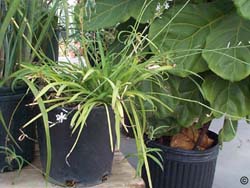
What are spider plants?
The common houseplants Chlorophytum comosum go by the common names of “spider plant” or “airplane plant.” They are typically grown and sold in hanging baskets. The plants fill the baskets with graceful, thin strap-like leaves. In response to the shorter day lengths of fall, mature plants will send out long branches with a small cluster of white flowers on the end. Small plantlets develop after the flowers. Plantlets can be rooted for new plants; remove them from the main plant and place them in moist potting soil or water.
Do spider plants need a lot of sunlight?
Spider plants thrive in bright, indirect sunlight, but exposure to direct sunlight will result in leaf scorch. Day-time temperatures in the moderate range, 65-75°F, are preferred. Spider plants are sensitive to cold temperatures, and it is best to move them away from cold windows during the winter.
How much water do spider plants need?
As with other houseplants, spider plants require less water when they are not actively growing in the fall and winter months unless they are placed in a drafty location near a heat register. Size of the plant, growth activity, environment, container size and type, and soil mixture all play a part in determining the frequency of watering. Check the soil frequently and observe the plant for signs of dryness. Water thoroughly in response to the plant’s needs, allowing a bit of water to leach through the bottom of the container to ensure no salts build up in the soil.
Should I fertilize my spider plant?
Fertilize spider plants with a complete, water-soluble fertilizer for houseplants. Feed plants once a month during active growth. Refer to the manufacturer’s recommendations to determine the appropriate amount of fertilizer to use. Avoid over fertilization as it is one of the conditions that can contribute to brown tips on the leaves. Other causes include over watering, allowing the plant to become too dry, low humidity and drafty air flow.
Should I repot my spider plant?
Spider plants need to be repotted or divided more often than many other houseplants. They have fleshy roots that will push the plant out of the pot or can even break plastic pots when they outgrow the container.
A great plant for beginners, the spider plant has also been found to be beneficial at cleansing the air of toxic gases in a home or office according to a NASA study.
For more information, see the following Planttalk Colorado™ video(s).
For more information on houseplant care please see:



